Forex Brokers: IKOFX
About IKOFX:
IKOFX has been established for the purpose to help Investor in success of Forex. With the help of latest news feed, and world wide information gathering, IKOFX is aimed to bring online forex trading to the next higher level. During hash time of current economy downfall, forex trading is what the world most needed to boost up the economy.
The IKOFX Company provides services for currency trading on the international financial Forex market. The company's main working directions are: providing qualified investment services aimed at earning speculative profit on international financial trading markets. IKOFX had operating experience and distribute among Asia countries and Middle-east countries. Currently, there are about a thousand of traders are using our services provided.
Website Link :
Country :Cyprus
Regulation :CySEC - Cyprus Securities and Exchange Commission
Introducing Broker (IB) :Yes
Dealing Desk :Market Maker (MM)
Trading Platform(s) :MetaTrader 4 (MT4)
Mobile Trading :Yes
Pairs Offered 23:
Type of Spread :Fixed
Commission / Fee :No
Maximum Leverage :500:1 (0.2%)
Free Demo Accounts :Yes
Minimum Initial Deposit - Mini US $1
Minimum Initial Deposit - Standard US $2,000
Multi-Currency Accounts USD - US Dollar
Smallest Lot Size :100
Swap Free Accounts: Yes
Account Funding Methods :Wire • Liberty Reserve • Local Depositor
Scalping: Yes
Hedging: Yes
Gold Trading: Yes
Languages: English
WELCOME BONUS
Every client has a right to receive the Welcome Bonus in the amount of 20 USD/50 USD/100 USD/500 USD to his trading account in case initial deposit balance of a trading account is as following:
* 1 standard lot is equivalent to 10 mini lots.
* example: deposit USD100 you will get USD20 bonus , but cant withdraw the bonus, you must trade up 10 standart lot= USD10 so you can withdraw your bonus now,if not just only can withdraw your USD100 only.
Why Trader Trade in IKOFX:
Minimum Deposit as low as USD 1
Commissions-Free Trading
Instant Orders Execution
Flexible Leverage Up to 1:500
Swap-Free Accounts
Competitive Dealing Spreads as Low as 2 Pips
(Local deposit & withdraw not any charges)
































